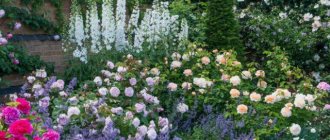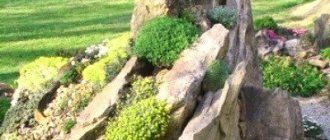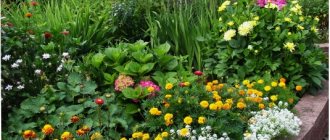Address: Kirova Avenue
The Tsvetnik Park, one of the main attractions of Pyatigorsk, is located in its oldest part and stretches along a small section of Kirov Avenue. This is the historical and cultural center of the city. In these places, at the base of Goryachaya Mountain, the construction of a resort began in the 20s of the 19th century.
.
From the history of the city it is known that the first spring was discovered on this mountain, and the first spontaneously arose village was called Hot Waters
.
History of the park
Water flowing down the slopes of Goryachaya Mountain accumulated in a low-lying wasteland, where a swampy area gradually formed. Architects Bernardazzi brothers
, who came to build Pyatigorsk as a resort town, when planning it, paid attention to the swamp that spoiled the view, near which the first medicinal baths were already operating. It was decided to take measures to drain the swamp and create a recreation area here. Which is what was done.
The swamp was drained, the wasteland was cleared of debris, the place was planted with ornamental shrubs and arranged with flower beds, in which about 40 types of flowers were planted. Alleys were also organized along which imported trees were planted. The park was originally called Nikolaevsky Flower Garden
, in honor of the reigning Tsar Nicholas the First.
This place has become a favorite walking spot for vacationers. Over time, drinking pump rooms and pavilions for the sale of mineral water and kumiss were built, a cafe, a book kiosk, an orchestra platform, a fountain, a sundial were opened - the park became widely known and popular. An amazing openwork building was built at the entrance - A.A. Gukasov’s coffee shop
, the entrance is decorated with openwork gates.
Coffee house of A.A.Gukasov
Subsequently, the Tsvetnik park became more and more beautiful and interesting. New original architectural structures and monuments have appeared, which we invite you to explore.
When entering the park, you immediately pay attention to the most famous literary hero, who modestly lowered his head - this is a monument to Kisa Vorobyaninov
. Indeed, on the pages of “The Twelve Chairs”, in the chapter dedicated to the stay of diamond seekers in Pyatigorsk, it was here - at the entrance to the park - where there were a lot of cheerful people walking, music was playing, and Narzan was being sold, Ostap set his unlucky partner to beg. So he still stands here. A photo with Kitty will put you in a good mood for many years.
Monument to Kisa Vorobyaninov
From the monument to Kisa Vorobyaninov, we will continue our path along the main alley, and soon, on the right, we will see a light, blue and seemingly airy building made of colored glass and metal. This is one of the “calling cards” of the city, a famous landmark of Pyatigorsk – “Lermontov Gallery” (Kirova Ave., 21). Built at the end of the 19th century, it is now a concert and exhibition institution.
Lermontov Gallery
The next building along Kirova Street after the Lermontov Gallery is the famous Yermolov Baths
(Kirova Ave., 21, building 1), named in honor of General Ermolov, who, as governor of the Caucasus, personally visited Hot Waters in 1816 and ordered the construction of medicinal baths in this place. The wooden baths that were built soon served people for more than half a century. A.S. received treatment there. Pushkin. Those first baths, of course, have not survived, but the present ones are in a beautiful building, built in 1880 of yellow and red brick with various decorative details that make it an ornament of the city and another of its attractions. The new stone building belonged to the military department and was intended for the treatment of military personnel.
Ermolovskie baths
Opposite is the modern Drinking Gallery
(Kirova Ave., 26 a), near which you must definitely stop and drink the wonderful healing Pyatigorsk water. The two-story Gallery was built in 1972. On the first floor you can drink water of the Essentuki type (salt-alkaline - source 17), on the second - hydrogen sulfide and carbon dioxide waters from the Krasnoarmeysky spring. Here you can also buy various dietary supplements, healing mud from Lake Tambukan and all kinds of souvenirs.
Drinking gallery
During the time of Lermontov, on the site of the Drinking Gallery stood the very first church of Pyatigorsk - Skorbyashchenskaya
(Our Lady of Sorrows), built by the Bernardazzi brothers in 1827. And although there was no funeral service for Lermontov before his burial, his death was recorded in the book of this particular church.
While you are drinking water, pay attention to the buildings located next to the gallery. On the left is a two-story building made of yellow and white bricks (Kirova Ave., 22). Its decor is not so bright, but it is still very interesting both historically and architecturally. This building was built at the end of the 19th century for the First City Parish School
in the southeastern part of the lands of the Sorrow Temple. The school building had rooms for staff and a section for girls. The school's large hall was also used for congregational meetings. During the Soviet years, the building was somewhat rebuilt and occupied in different years by the Main Resort Administration of the city, an evening school for working youth, and an inhalation center. Today it is a multifunctional building.
But to the right of the Drinking Gallery is the four-story elegant building of the former most expensive and comfortable hotel in the city of the early 20th century - the Bristol Hotel.
(Kirova Ave., 26). With its front façade, the building in the neo-Renaissance style looks out onto the Tsvetnik Park.
Hotel Bristol
Today it houses the reception office of the President of the Russian Federation in the North Caucasus Federal District.
After drinking mineral water, we return to the Lermontov Gallery, behind which are the Lermontov Baths
(formerly Nikolaevskie). They were built by the Bernardazzi brothers in 1825-31 on the initiative of General Ermolov in the classical style - simple and elegant. This was the first capital structure for mineral baths at Minvody. In those days, the Nikolaev baths were considered the best in terms of amenities and comfort.
Lermontov baths
In Soviet times, they began to be called Lermontovsky in memory of the poet, who received treatment here in 1837, which was recorded in the document about the receipt of money from visitors.
Fountain "Lucky Catch"
Rounding the Lermontov Gallery on the left and passing the “Lucky Catch” fountain
, look up.
On the slope of Mount Goryachaya there is a beautiful building that looks like a medieval castle, very well integrated into the mountain landscape. Now it houses the “Hot Key” Sanatorium for children with their parents (Bernardazzi, 1), and at the end of the 19th century it was the house of the chief architect of the Ministry of Water Resources in the 40-60s. S.I.
Upton , which he built for his family. The family occupied the first floor, and the second was rented out to vacationers.
House of S.I. Upton
And at this time we went to another attraction of the park - Diana's grotto
. The Bernardazzi brothers, on the orders of General Emmanuel, who replaced Yermolov, created this artificial grotto in honor of the first human ascent of Elbrus in 1829. The grotto was originally called the Grotto of Elbrus, but then the same General Emmanuel ordered it to be renamed the Grotto of Diana, the ancient goddess of the hunt.
In those days, young people loved to organize small balls in this grotto.
A week before his tragic death, Lermontov took part in one of these balls. The grotto was then beautifully decorated with colored lanterns and Persian shawls; Lermontov himself came up with the idea and with his friends made a huge three-tier chandelier entwined with flowers and creeping plants. There was an orchestra above the grotto, and the music seemed to pour from heaven, and the dances themselves took place on the platform in front of the grotto. As eyewitnesses of Lermontov's last party later recalled, the poet was very cheerful and danced a lot. A memorial plaque located in the grotto will remind you of these events. Diana's Grotto
Until the end of the 19th century, this is where the Flower Garden park ended. But at the beginning of the 20th century it was continued by the artificially created Nagorny Park
, which begins to the left of Diana’s grotto with an ascent to Mount Goryachaya. The idea to create a park on Goryachaya Mountain with alleys and resort trails, gazebos and sculptures belonged to the then director of KavMinVod V.V. Khvoshchinsky.
The climb up the mountain is quite steep, but quite doable. And most importantly, the mountain causeway will bring you many new unforgettable experiences. Very soon a bronze Eagle Sculpture
- symbol of KavMinVod.
The sculpture was installed in 1973 (by N.M. Khaustov) at the site of the discovery of the first Pyatigorsk mineral water source. This is the second sculptural image of the Eagle. The first plaster Eagle was made by L.K. Shodkiy
and installed in 1901.
Sculpture of a bronze eagle - a symbol of KavMinVod
The Chinese gazebo is clearly visible from Orel
. You can approach it, or you can admire it from afar. This is also a modern design of the observation deck (by I.F. Shakhovskaya). Before the revolution, there was a Colored Gazebo in this place.
As you continue your way along Goryachaya Mountain, pay attention to the vegetation surrounding you - trees and shrubs. The fact is that there was no soil on Mount Goryachaya. Imagine the amount of work completed on landscaping the territory of Nagorny Park! After all, everything that grows here is planted by human hands.
As you climb the mountain path, on the left you will see the floating silhouette of a white gazebo, which is located on the high terrace of the opposite Mashuk Mountain. This gazebo is called the Aeolian Harp. It was once a musical gazebo. A stone structure in an antique style was built by the Bernardazzi brothers on an observation deck, which offers views not only of Pyatigorsk, but also of the Main Caucasus Range, for inspection of which a telescope is installed there.
Aeolian harp
Admiring the views of the mountain landscapes, we quietly approached another attraction of the park - the Academic Gallery (Kirova Ave., 1 a). Although, it is difficult to say which park this gallery belongs to, because another equally famous and old park in Pyatigorsk, Emmanuelevsky, begins from it.
The Academic Gallery was built on the site where the first Pyatigorsk drinking spring was opened - before that, the resort only took baths. Initially, a well and a wooden gallery were built here to protect from the sun. This well is again described by Lermontov in “Princess Mary”. It is near him that the main characters meet, which then ends so dramatically. Now the Gallery building houses the Insect Museum.
Academic gallery
This completes the journey through the Tsvetnik Park and Nagorny Park. Choose for yourself where to move next.
For example, from the Academic Gallery, along a wide stone staircase built in 1932 (architect P.P. Eskov), you can go down to the former Pyatigorsky Boulevard (now this is the very beginning of Kirov Avenue). There is also something to see on this small section of Kirovsky Prospekt - the Pushkin Baths
(Kirova Ave., 3) and
“House of Princess Mary”
(Kirova Ave., 12), Operetta Theater (Kirova Ave., 17) and Pirogov Resort Clinic (Kirova Ave., 19). And then, the airy Lermontov Gallery, already familiar to us, behind which is the gate from the Tsvetnik park.
Entrance to Tsvetnik Park in the evening
If you have the strength and time, then by continuing along Krasnoarmeyskaya Street (formerly Elizavetinskaya) to the right of the Academic Gallery, and then along Gagarin Boulevard, in half an hour you can reach the famous lake “Proval”.
Lake Proval
Or you can go on a new climb up the slopes of Mount Mashuk to the ancient Emmanuel steam to
, which houses famous Pyatigorsk attractions: Lermontov’s grotto, the Aeolian Harp gazebo, and from the park’s many observation platforms you can admire the wonderful views of Pyatigorsk and the Main Caucasus mountain range.
Flowers in the city
Flowers are cramped in the city, and it is not surprising that they strive to conquer a new living space for themselves. And people come to their aid, arranging flower beds on balconies, roofs and even... lamp posts.
Not long ago, the ancient Belgian city of Ghent became the scene of a world achievement listed in the Guinness Book of Records. In the city center, at a height of 26 meters, the “Ghent Flower Basket” was mounted on special metal structures. It was invented and performed by Jos de Troyer, who decided to break the record that belonged to the British. The world's largest flower basket, made in England, had a diameter of 8 meters 93 cm. The Belgian florist increased the world record by 1.5 meters. His floral masterpiece is 10.5 meters in diameter and weighs no less than 45 tons. To decorate such a “basket” it took 32 thousand flowers. Under the tent of this unprecedented flora attraction, there was a Flower Square with a pond, colorful flower beds and cozy cafes. The kiosks along the walking path sold hanging plants and souvenir mini-baskets. And having climbed the stairs or the elevator to the very top, you could see the entire Square of Flowers and admire the panorama of the famous historical center of Ghent.
Flower baskets have recently become common among Russian citizens. But vertical flower beds are just beginning to take over our streets. They are containers for plants arranged in tiers. This design does not require much space at the base, but has a large effective volume for planting plants vertically, which significantly increases the total area of urban gardening, and therefore is very environmentally friendly. Such flower beds are in perfect harmony with the verticals of multi-storey buildings and with the open space of squares, but are especially indispensable where the territory is limited.
Plants in vertical flowerbeds, due to their tiered arrangement, are in equal conditions with regard to growing conditions - light, humidity, nutrition. With the exception of watering, they require virtually no maintenance - loosening, weed control, which significantly reduces maintenance costs. You can even skip the planting stage by purchasing or renting ready-made vertical flower beds with well-grown plants that immediately have a highly decorative appearance. But creative people should not deprive themselves of the pleasure of creating their own, unique composition, which in a couple of weeks will be just as beautiful, and will also allow you to save a lot.
Various manufacturers offer vertical flower beds made of concrete, plastic, stainless steel - all of them are suitable for growing plants. You just need to take into account that plastic ones are the least durable, concrete ones are too heavy, and metal ones, reminiscent of the Hi-teck style, will not always harmonize with the decoration of the building and the surrounding landscape. True, over time they will be covered by plants, and this drawback will disappear.









